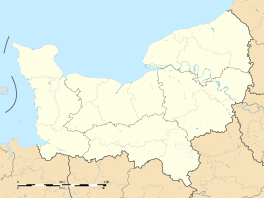Villers-sur-Mer
| Villers-sur-Mer | ||
|---|---|---|

Casino
|
||
|
||
| Coordinates: 49°19′17″N 0°00′18″W / 49.3214°N 0.005°WCoordinates: 49°19′17″N 0°00′18″W / 49.3214°N 0.005°W | ||
| Country | France | |
| Region | Normandy | |
| Department | Calvados | |
| Arrondissement | Lisieux | |
| Canton | Trouville-sur-Mer | |
| Intercommunality | Cœur Côte Fleurie | |
| Government | ||
| • Mayor (2008–2014) | Gérard Vauclin | |
| Area1 | 8.99 km2 (3.47 sq mi) | |
| Population (2008)2 | 2,652 | |
| • Density | 290/km2 (760/sq mi) | |
| Time zone | CET (UTC+1) | |
| • Summer (DST) | CEST (UTC+2) | |
| INSEE/Postal code | 14754 / 14640 | |
| Elevation | 3–136 m (9.8–446.2 ft) (avg. 38 m or 125 ft) |
|
|
1 French Land Register data, which excludes lakes, ponds, glaciers > 1 km² (0.386 sq mi or 247 acres) and river estuaries. 2Population without double counting: residents of multiple communes (e.g., students and military personnel) only counted once. |
||
1 French Land Register data, which excludes lakes, ponds, glaciers > 1 km² (0.386 sq mi or 247 acres) and river estuaries.
Villers-sur-Mer is a commune in the Calvados department in the Normandy region in northwestern France.
The Prime Meridian makes landfall in Villers-sur-Mer after crossing the English Channel.
The town had a population of 2652 in 2008, a growth of just over 1,000 residents since 1962.
Villers-sur-Mer is known for the large topiary dinosaurs facing the sea from the garden of the office of tourism. In certain years, a baby dinosaur is added to the garden.
Villers-sur-Mer is the starting point of the Vaches Noires cliffs - a site where many fossils have been discovered. A mini museum in the enclosure of the office of tourism, and has an outline of the resources and discoveries. It is a place universally known by specialists in the ammonites and other fossils.
Villers-sur-Mer station is on the line from Deauville to Dives-sur-Mer. The station building is no longer open but train services operates year-round on weekends as well as on weekdays during the summer.
...
Wikipedia



